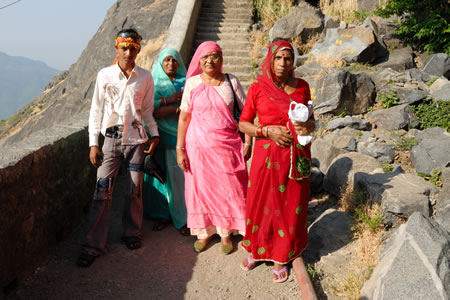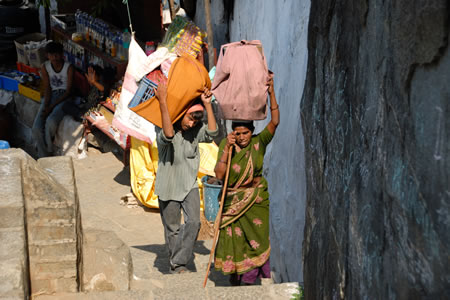English | Dutch |
|
| 7,000 steps to the top | |
Diu (India), November 9th 2007 |
|
The Girnar hill, close to Junagadh in Gujarat, is a pilgrimage destination for both Jains and Hindus. Believers come from all over India to make the pilgrimage of 10,000 steps to the top, through a very nice landscape. The views are sometimes stunning. Most people start their pilgrimage a little bit higher on the hill, at the point where the road ends. From than point, they only have to do 7,000 steps, in stead of the full 10,000. We also start at this point, to increase our chance to reach the top. Our alarm clock wakes us a 05.00 a.m... It is still dark outside and the cold that Ivonne has already several days, brings us in doubt if we should undertake this journey. We decide to give it a try. We bought some bananas, biscuits and bread on the market yesterday for our breakfast. After we filled our stomachs we leave the hotel to find an auto-rickshaw to take us to the start of the trail. A couple of minutes later we are on the way to Girnar. The Girnar hill is a hill with several Jain and Hindu temples built on it. You have to climb all 7,000 steps (if you start higher on the hill) to visit them all. We start a step zero at 06.00 a.m... It is still dark and cool and this is the best time to do the pilgrimage. Some people decide to start during the hottest hours of the day, because it ‘delivers up’ more karma because it takes more effort to complete the climb. When we look up the mountain, we see lights that mark the trail. During the first part of the trail we see a lot of people who offer to carry us all the way up the hill. It is their business to carry people up for a fee. The fee depends on your weight. We reject their offer because we want to make it on our own. The first 1,000 steps are quite heavy. It is still cool, but we are already sweating a lot. We decided that we would take a rest after every 2,500 steps. At around step 1,500 there is a change. We find the right pace and things seem to go easier. |
|
 |
|
Pilgrims on their way to the top of the Girnar hill |
|
Just before our first planned rest, we meet and Indian man, who lives in Canada. He is dressed completely in white, and is carrying a stick. He is a Jain pilgrim and we decide to join him in the climb up. During the climb, he tells us more about the Jain religion. Important principles of the Jain religion are not to use violence and be a strict vegetarian. Jains are fasting in the Monsoon months. During the fasting period they only eat dry food like rice and biscuits, and no ‘wet’ vegetables. The reason is that in the wet vegetables there are a lot of bacteria’s, especially in the wet season when the bacteria’s population even grows faster. To prevent killing a lot of bacteria’s while cooking the vegetables, they do not eat the wet food during the fasting period. Jains also believe that their religion has always been there, and that it will never disappear. They believe in reincarnation and that all your thoughts and deeds in your present life will have influence on your next life. All thoughts and deeds are put in one big ‘formula’ and the outcome determines how your next life will be. If you give money to people who need it for example, you will also get money in your next life if you will need it. And if you kill somebody in your present life, you will also be killed in your next life. Jainism looks a little bit like Hinduism. One of the biggest differences however, is the fact that Jains do not believe in the caste-system. Jains believe that everybody should have the chance to build up a good life, regardless their background. At around step 3,000 he tells us that there are no 7,000 steps, but only 3,800. He is correct if you only count the steps that take you to the Jain temples. If you want to see also the Hindu temples that are further on the hill, you really have to climb all 7,000 steps. At step 3,800 we reach the Jain temples. We go through an old gate and enter the area where the Jain temples are located. The temples are beautiful with mosaic tiled roofs. We say goodbye to the man and move on with our journey further up the hill to the Hindu temples. Just after we started, we meet a group a young men from Rajkot (Gujarat). They are Hindus and came to Junagadh to climb the hill. They confirm to us that we have to climb another 3,200 steps to reach the last temple. 1,200 steps to the Amba Mata temple and another 2,000 steps to the Dat Tatraya temple. They young guys are Economy students (from a higher caste) and they see themselves as the future leaders of India. They are very confident about themselves. | |
 |
|
All merchandise on the Girnal hill must be carried on foot |
|
| The first stretch to the Jain temples was great, but the second part of the trail to the Hindu temples is even more beautiful. The trail finds its way through the hills that are covered by beautiful yellow grass. They sun is still standing low which gives beautiful light. There are people everywhere undertaking their own pilgrimage. You see groups of young people, families, but also individuals finding their way on the blue-grey stones of the stairs. Once in a while we pass old men and women going up the mountain very slowly, on their bare feet. Some young people have red-gold coloured ribbons around their head, to honour the god of the education. Once in a while you pass small temples that are guarded by spiritual men with painted faces. Along the trail are many drinking stalls where you can buy a tea or a chilled soft drink. All the merchandise is carried up by porters, because there are no roads available to stock the shops.
We are happy and satisfied when we reach the Dat Tatraya temple after the 7,000 steps. It took us almost three hours, which is not bad at all. At the temple we also meet the young guys from Rajkot again. We share some biscuits with them and talk about the pilgrimage and the temples. After we finished the biscuits, Ivonne put the empty packaging back in her daypack. One of the guys tells her just to trough it away on the ground. We refuse of course, because we do not want to spoil this beautiful area. We tell them that it is better to keep the environment clean and not spoil it. We were amazed to hear what one of the guys said: “we respect the fact that you do not want to throw the rubbish away and that is the difference between your and our government. We are allowed to do that while it is forbidden in Europe”. It is even more amazing if you know that these guys see themselves as the future leaders of the country! After we spend some time at the temple, we started with the descent. We let the young guys go, because they run down like young dogs. We want to spare our knees and take a photo once in a while, so we take it easy. Halfway the trail we buy some drinks for twice the normal price. We know however how much effort it takes to get these drinks on the hill, so we are glad to pay it. At around step 2,500 we meet the guys again. They were taking a rest under a tree and drinking some butter tea. We continued the descent together with them and started talking about the differences in the culture between India and the western world. They talked enthusiastically about the cast system and about how good it is. They also talk about the fact that they look down on love marriages. For them it is unbelievable when they hear that young people in the western world find their own partner. They believe that the parents can make the best choice because they have more experience in life. Love can never be the only base for a good marriage. Also the consequence that some people never marry in the western world (because they do not want to) is a horrible scenario in India. At around 12.30 p.m. we arrive at the base of Girnar hill. We finished our ‘pilgrimage’. Our legs are still quite good and we are happy that we decided to do this great walk. We say goodbye to the guys, exchange some email addresses, and take a rickshaw back to Junagadh. The pilgrimage was not only very beautiful, but it is also a great way to meet local people. | |